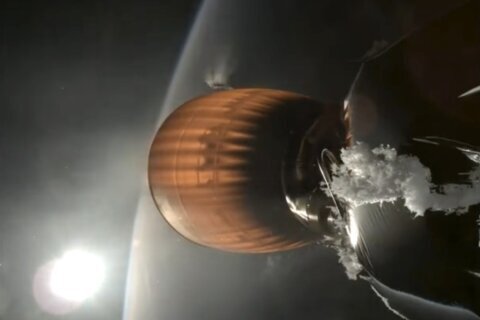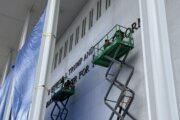NASA held a media teleconference Tuesday to discuss the status of the long-awaited James Webb Space Telescope. The JWST had been slated for a launch in 2018 and then 2019. NASA announced Tuesday that it has now tentatively scheduled launch for May 2020.
Acting NASA Administrator Robert Lightfoot said, “Webb is the highest priority project for the agency’s Science Mission Directorate, and the largest international space science project in U.S. history.”
“All the observatory’s flight hardware is now complete,” Lightfoot added. “However, the issues brought to light with the spacecraft element are prompting us to take the necessary steps to refocus our efforts on the completion of this ambitious and complex observatory.”
The JWST consists of two separate elements: the optical telescope element, or OTE, and the spacecraft element to which the OTE is attached.
The OTE consists of the 6.5-meter telescope and its instruments. Over the years, it was built, assembled and tested at NASA’s Goddard Space Flight Center in Greenbelt, Maryland, before being completed last year.
The OTE then underwent months of additional successful testing at NASA’s Johnson Space Flight Center in Houston, Texas. In early 2018, the OTE was flown by a C-5 aircraft to California for integration and testing with the spacecraft element.
The spacecraft that the OTE will be integrated with was built by primary contractor Northrop Grumman. It consists of a five-layer sunshield the size of a tennis court to protect the OTE from heat of the sun, moon and Earth. The spacecraft also carries solar panels and batteries for power, radio communications and propulsion systems, and the avionics/on-board computer system.
The spacecraft will fly the OTE out to a gravitational point called L-2, 1 million miles from Earth, where the telescope will operate just 40 degrees above “absolute zero.”
For the first time in the project’s history, both elements are at the same facility in Redondo Beach, California, for integration and testing.
It was during the testing of the spacecraft element that several technical issues arose.
NASA said in a press release Tuesday, “Testing the hardware on the observatory’s telescope element and spacecraft element demonstrate that these systems individually meet their requirements. However, recent findings from the project’s Standing Review Board (SRB) [sic] indicate more time is needed to test and integrate these components together and then perform environmental testing at Northrop Grumman Aerospace Systems in Redondo Beach, California, the project’s observatory contractor.”
Because JWST, consisting of both integrated elements, has to be folded up in order to fit into the payload fairing of the European Space Agency’s Ariane-5 rocket, a complex deployment sequence has to take place in the proper order.
Part of this sequence is the unfolding of the large sunshield. During testing of the sunshield’s folding process and subsequent deployment sequence, it was found that tears developed and the sunshield’s tensioning cables had to be redesigned, as the original design left too much slack.
Additionally, there were problems that developed with the spacecraft’s propulsion system, specifically thruster valve propellant leaks. A technical issue with transducers also developed.
The discovery and fixing of these issues, the ongoing complex integration of the two JWST elements, plus the time needed for rigorous and thorough testing of the completed integration all led to the slipping of the launch date.
Dr. Thomas Zurbuchen, associate administrator for NASA’s Science Mission Directorate, said, “We have a 70 percent confidence level for the May 2020 launch date. Rigorous testing is needed; we need to do it right on the ground, and failure is not an option. We want to get to a higher confidence level and will take no shortcuts.”
Besides the technical issues, JWST has a Congress-mandated spending cap of $8 billion. Lightfoot said, “NASA has spent $7.3 billion so far. If JWST needs more funding than the $8 billion, it will take a reauthorization from Congress.”
To determine more accurately the launch date and costs of JWST, NASA’s Tuesday press release revealed, “NASA has established an external Independent Review Board (IRB) [sic], chaired by Thomas Young, a highly respected NASA and industry veteran who is often called on to chair advisory committees and analyze organizational and technical issues.”
“The IRB findings, which will complement the SRB data, are expected to bolster confidence in NASA’s approach to completing the final integration and test phase of the mission, the launch campaign, commissioning, as well as the entire deployment sequence,” NASA added.
“Both boards’ findings and recommendations, as well as the project’s input, will be considered by NASA as it defines a more specific launch time frame. NASA will then provide its assessment in a report to Congress this summer.”
When I asked Zurbuchen what he thought was the most critical step going forward, he replied, “To learn how to make the changes to ensure (JWST) mission success using lessons learned to get better, to do everything we could to ensure mission success.”
JWST “mission success” will be a 10-year cycle of observations revealing what we have never seen in the universe before: the first stars and galaxies forming, new discoveries in our own solar system and other planetary systems, and, most tantalizing, things we have not even imagined.
Stay tuned for more updates on the James Webb Space Telescope.
Follow my daily blog to keep up with the latest news in astronomy and space exploration. You can email me at skyguyinva@gmail.com.







